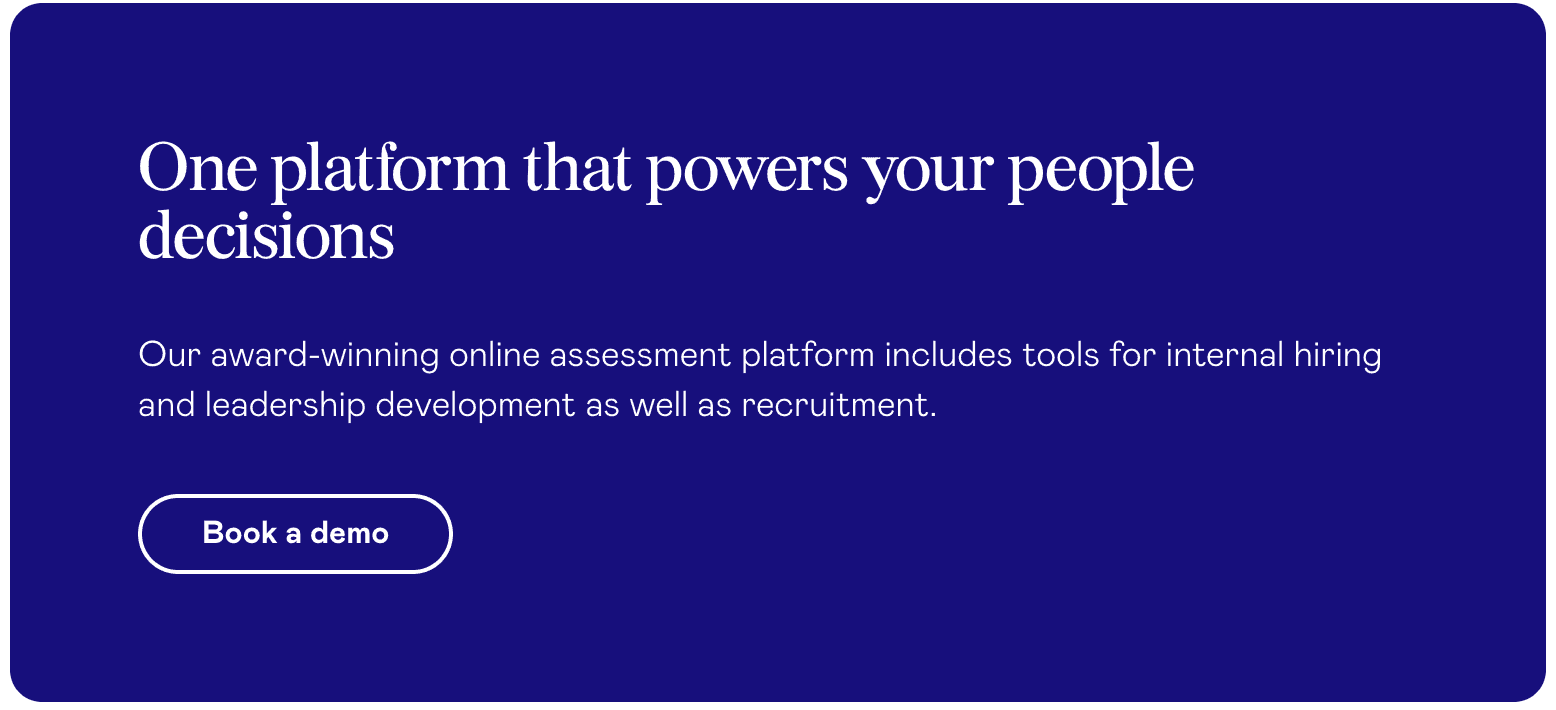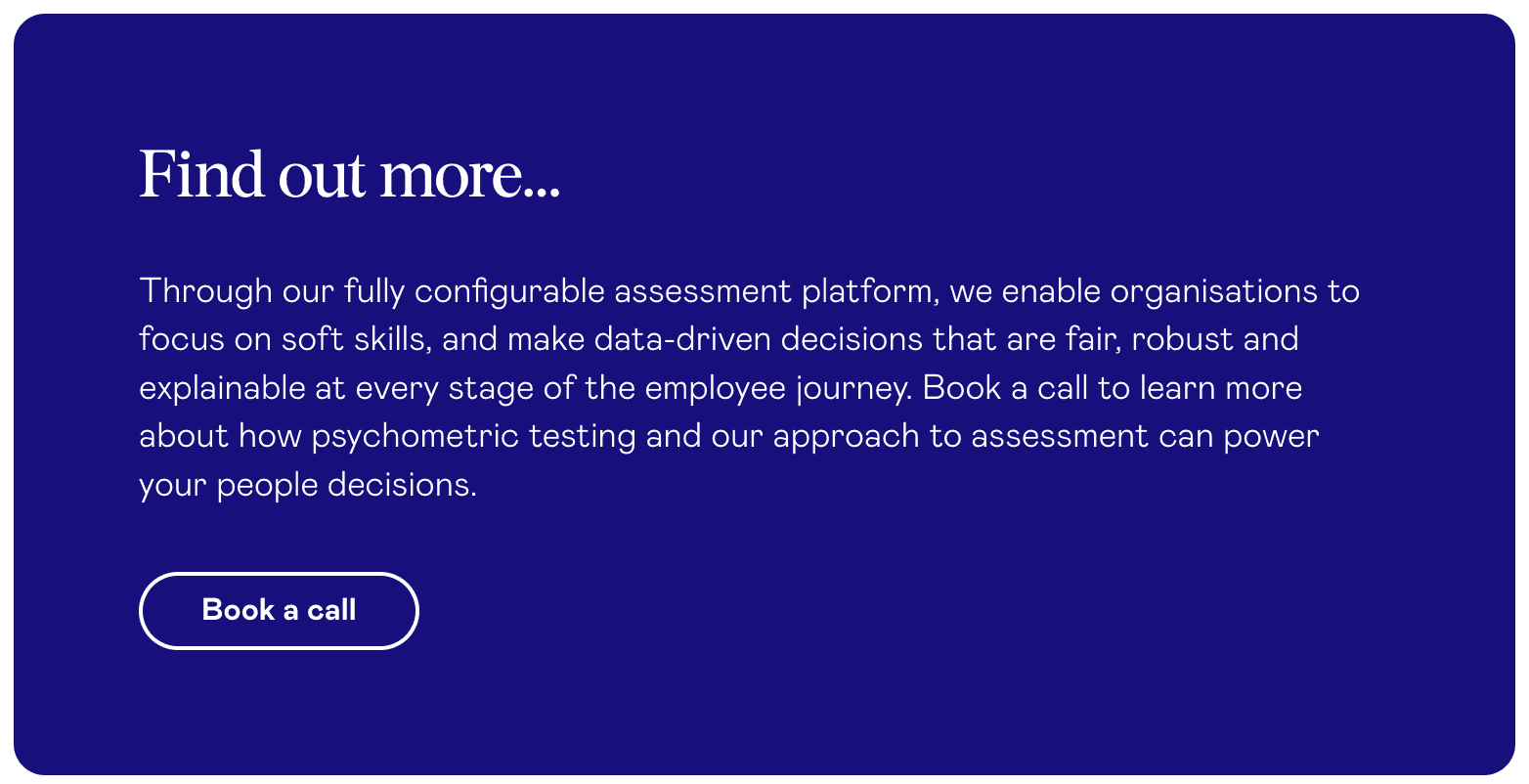Take a sneak peek of the product with an interactive tour | View now
Why change management is critical for successful talent and recruitment strategies

No matter how good your new assessment solution is, a successful rollout across the business can make or break the change. Switching to a new assessment solution has far reaching consequences for leadership, hiring managers and candidates. A strong change management plan needs to be in place to ensure that you and your organisation get the most from your new assessment solution.
Why does change management matter?
There is a proven correlation between effective change management and project success. Projects with excellent change management, are six times more likely to meet objectives than those with poor change management. Projects with effective change management are also more likely to stay on schedule and on budget, boosting overall success.
Change management should therefore be a major part of adopting a new enterprise-wide digital assessment solution. The project sponsor will need to reach out across business units and geographies to build out a plan and a team that are capable of bringing people along on the change journey.
How people, teams and organisations experience change
We know from our experience as psychologists that change prompts a fight, flight or freeze response for most people.
That means that faced with a new solution, people are likely to resist the change if they don’t know what it means for them - It’s going to take a long time; it will require a lot of training that we don’t have to do at the moment; it’s very resource intensive - might be some of the ways that resistance manifests itself.
Resistance can be seriously damaging to the success of a project. But, through effective change management, this natural human response to stress can be exchanged for support, advocacy and positive feelings about the change.
From our experiences of managing global, enterprise level assessment projects, here is our guide to designing a change management plan.
Designing a change management plan for a new assessment solution
Scoping the project
Scoping out the project from a change management perspective needs to begin sooner than you think. All too often, communication and rollout aren’t considered until almost the point of go-live. Planning how you will roll out and embed from the moment you choose a new solution will vastly improve the project’s chance of success.
When scoping the project, think of the process in three phases: preparation, management, and sustaining outcomes (see Prosci’s blog post for more on implementing change successfully), as there will be different activities that need to take place at each stage.
Winning stakeholder buy-in
For the new solution to stick, all your key stakeholders need to be on board. Firstly, having buy-in from the CEO is critical, as a lack of support from a key senior leader can undermine project success. But positive sentiment about the new solution needs to be embedded at all levels, and across functions and geographies too.
When thinking about who your stakeholders are, consider both internal and external roles from senior leadership and business unit managers to recruiters, employee experience teams and candidates. Consider what each stakeholder wants to get out of the project and what resistance you might face.
Building your project team
Who do you need on your team to drive and support the change? Be open minded in who you choose for your team that should include representatives beyond the obvious area of talent acquisition. Colleagues from functions including marketing, digital transformation, IT, and learning and development may be best placed to support you.
Think about who could own parts of the project, and make sure there is enough capacity within that team to deliver the project – no matter how committed you are, a core team of two or three people will not be able to secure enterprise-wide change.
Creating a communications plan
The first thing that your colleagues hear about the new solution should not be the launch! Well planned, effective, tailored communication about the new assessment solution is critical to its success. The best communications plans build momentum in the run up to launch and maintain it during and afterwards.
An enterprise-wide communications plan needs input from subject matter experts, so explore early on in the process what internal marketing resources you can lean on to build a brand around the change and tailor your message. Communication needs to come from all levels of the business, in a variety of formats and at the right time.
Generating internal advocacy
Advocates play a powerful role in building support for change. Advocates promote support for change with words and deeds and they can be from anywhere in the business and at any level. Building a network of internal advocates will help to cascade information, share knowledge, train teams, act as a sounding board and act as part of the feedback loop.
Advocates are important because they understand the internal workings of their area of the business. They know what education and support their colleagues will need to get on board with a change in direction.
Training and ongoing learning
Training does not need to be a training course. In fact, the most effective learning is on the job. If we apply the 70:20:10 rule then on the job learning during project implementation is a great source of learning – and another reason to do a thorough stakeholder analysis and build a project team at the start.
This is also a place where internal advocates are a huge asset, allowing training to be carried out internally by those who know the business. Internal advocates understand the starting points and learning gaps of colleagues, making them well placed for this role. A plan that allows people to learn holistically, creatively and in a way that enables them to effectively use the new solution, will increase the likelihood of successful rollout.
Rollout
Finally, it’s time to rollout the solution across the business. Bear in mind that in a large, global, networked business that its advisable to conduct a pilot first for one group (such as graduates) or in one market. This allows for the project team to learn and make changes before full scale adoption.
By this point ensure that you understand the key success criteria for each of your audiences. This will enable you to measure success on different metrics for different groups – for example, this could include quality of hire, time to hire, cost of hire or internal efficiencies. Benchmark against existing data where you can in order to build up a picture of the scale of change.
Sustaining the change
Once the solution has gone live there is still work to be done to sustain change. Firstly, create a forum or feedback loop so that users can raise issues and so that they have a voice to share what is working and what isn’t. This might be workshops, surgeries, surveys or candidate feedback. This information should feed into continuous improvement.
Check that people are equipped with the knowledge and skills they need to effectively adapt such as training, learning materials, coaching and mentoring. Make time to share successes too. Show the positive impact of a data-driven solution and recognise colleagues who have played a part in the project and who have adapted and successfully to the new solution.
Embedding digital change for the long term
The journey to a new talent or recruitment strategy begins long before launch. Within a global, networked company, it can take up to a year from planning to successful go-live of a digital assessment solution, based on our experience.
To maximise the project’s success, you need to take people on that journey with you from the beginning. A thorough project plan that is supported by all stakeholders, and a clear implementation strategy, are they keys to long-term project success.

